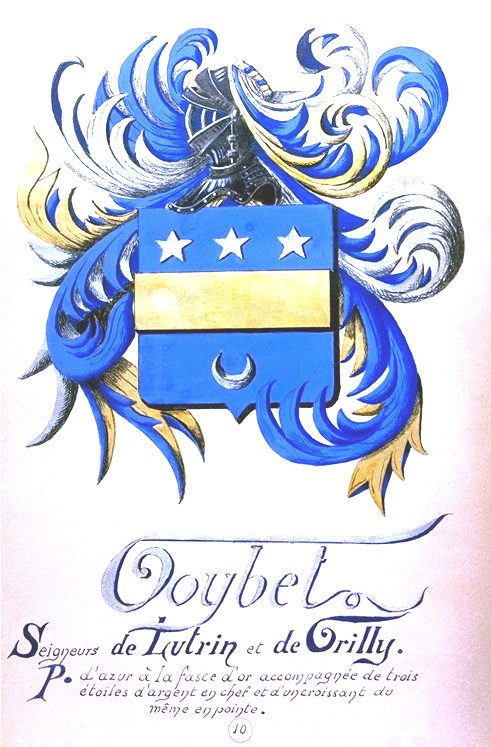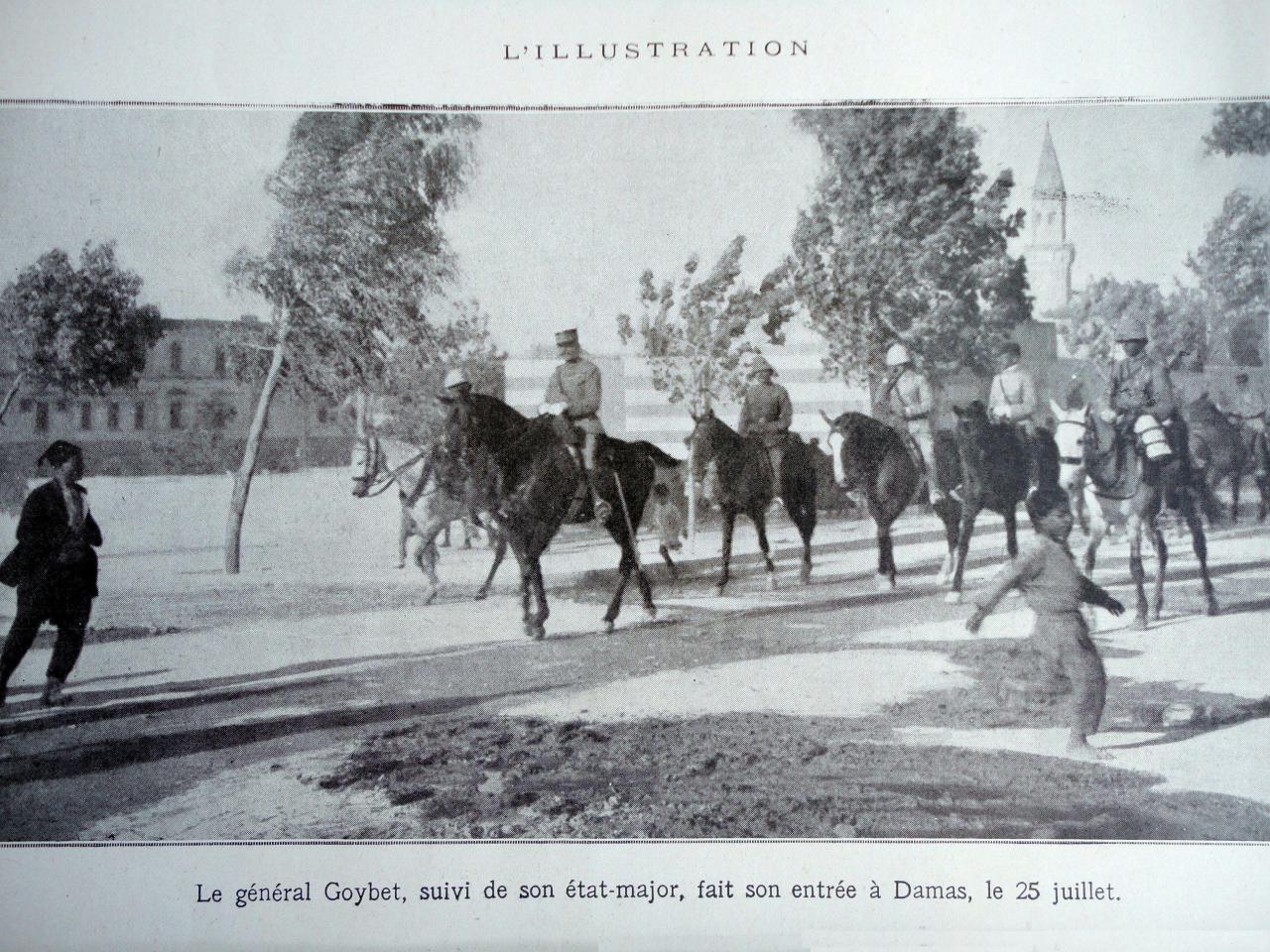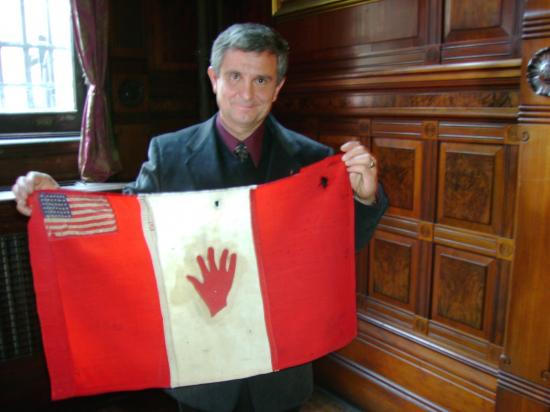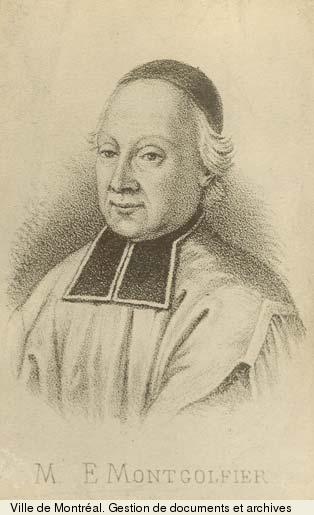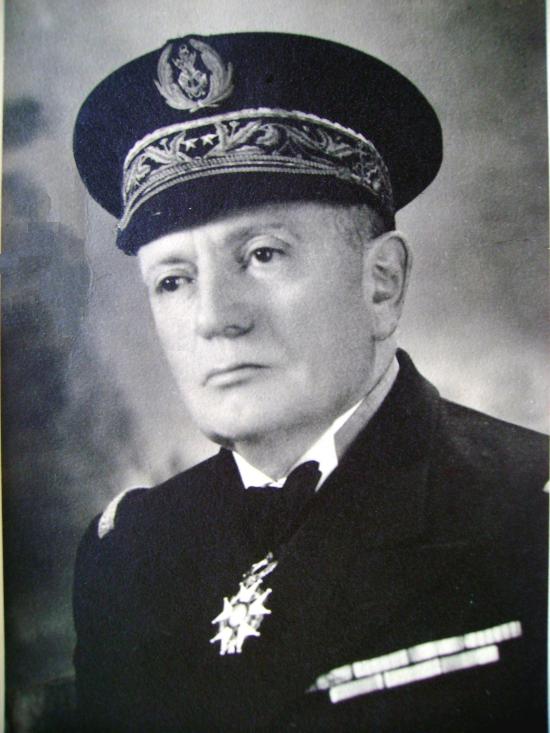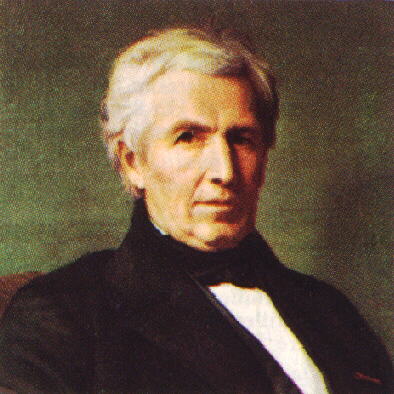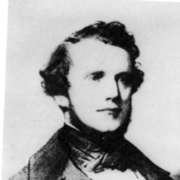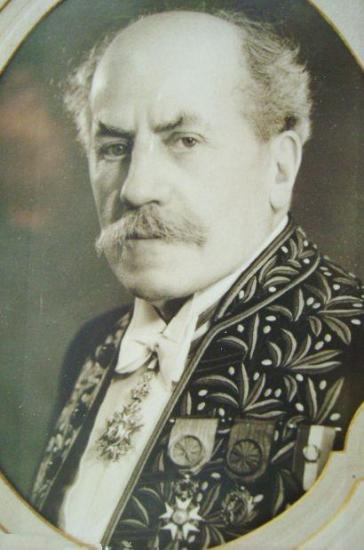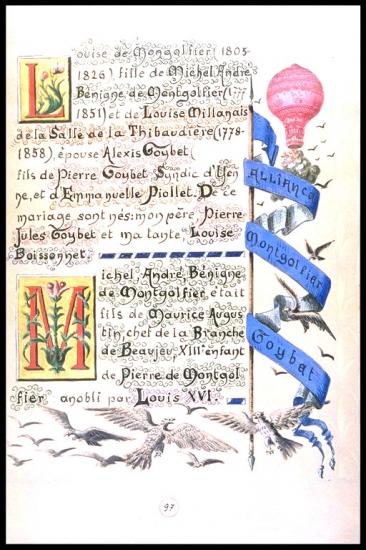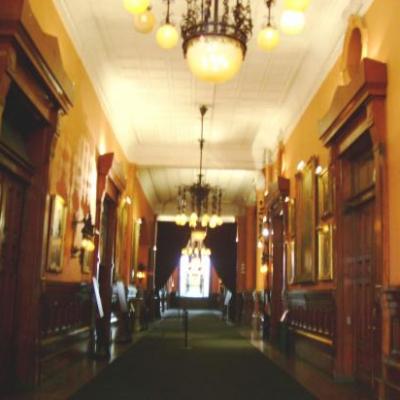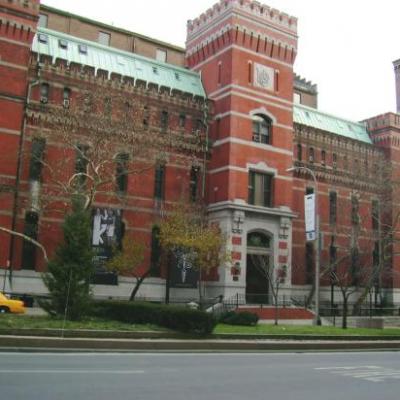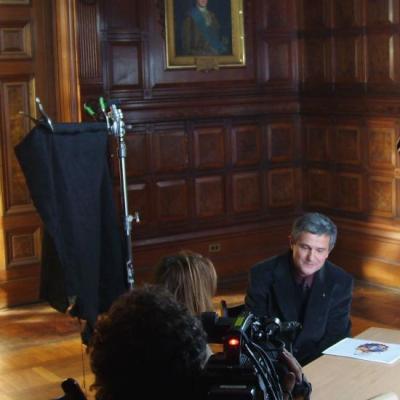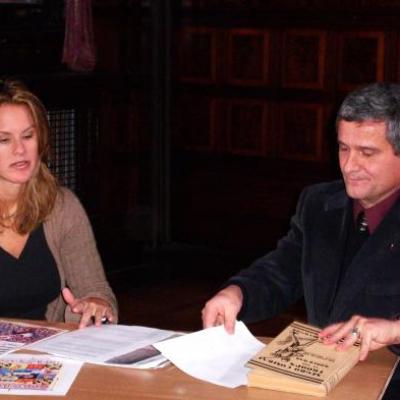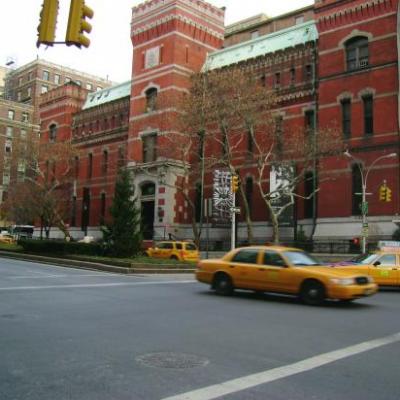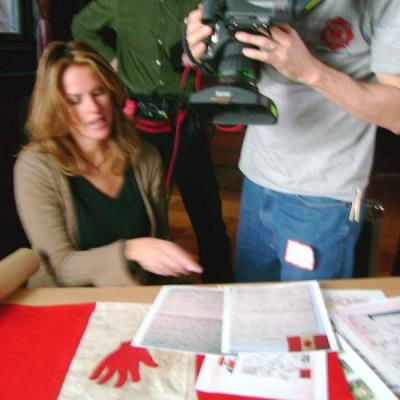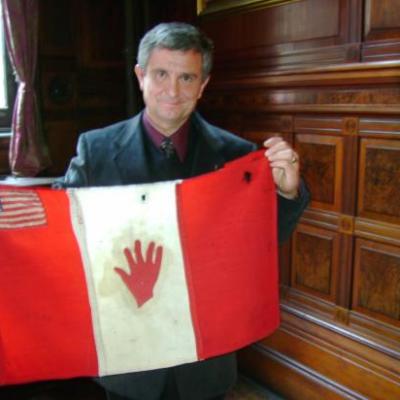Général Mariano Goybet and the Red Hand Division
MARIANO GOYBET AND THE RED HAND DIVISION
----------------------------------------------------------------------------------------------------
Written by Henri Goybet for thé African troops of Mariano Goybet who commanded thé Red Hand Division during World War.
Ecrit par le Chevalier Henri Goybet le 10-12-2007 en Hommage à Mariano et ses vaillantes troupes Franco Americaines.
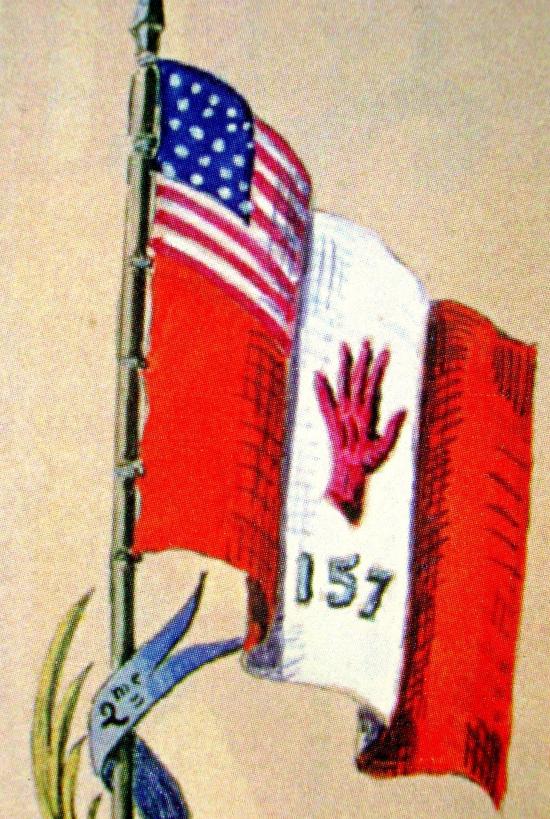
I kneel down to pay tribute to George Floyd and in solidarity with the African-American community
Signed Henry Goybet , author of this site, great grand son of General Mariano_Goybet commander of the 157 th Infantry Division (France) of the French army who participated in the First World War . This division was known when two regiments of African Americans (( 371 th US Infantry Regiment and the 372 th (including units of the National Guard 2 )) the "integrated it as the 157 th Red Hand Division (Red Hand Division) .This division, alongside the IV th Army , in the Champagne offensive , despite heavy losses, broke the German front in front of Monthois during the Combats du at . The three regiments are decorated with the war cross as well as many individual soldiers. the African-American Freddie Stowers will receive for his bravery the Medal of Honor , the highest distinction in the United States .
See also this link : 157th ''Red Hand '' Division
AN OLD SAVOYARD FAMILLY
The Goybet family is an old family of Savoie which can be traced back to the fourteenth century They descend from Louis VIII , father of Louis IX, “ St. Louis” and are allied to the best local nobility They were notaries, dealers, mayor, lords of the manor, military and industrial people.
One branch of the family was ennobled. There was a provincial governor in 1753 . He was called Goybet de Lutrin de Grilly. He oversaw the provinces of Chablais and Genevois. The family has a coat of arms: a field of blue with three silver stars at the head and an upturned crescent at the point. Traversing the center is a bar of gold.
Mariano was born in Saragoza, Spain in 1863 and died in Yenne, France in 1943.
He was the son of Pierre Jules Goybet , an industrialist (1823-1912) and Marie Bravais . She was the niece of the physician Auguste Bravais , who studied the composition of crystal.
His grandmother was Louise de Montgolfier, niece of the famous inventors of the hot air balloon. The first flight human flight in the world was made with the Montgolfière at the end of the eighteenth century.
Mariano’s father and uncle brought the fabrication of paper to Spain. He also fabricated steam machinery and was made Chevalier and a member of the superior Council of Industry by the Queen of Spain.
BEFORE THE WAR
Mariano was in the military school of St Cyr in 1884 and afterward attended L’Ecole de Guerre ( the school of war).
He married Marguerite Lespieau, the daughter of his general Theodore Lespieau. (Campaigns of Crimea , Kabyli and Commune .
In 1907 he took command of the 30th Alpine battalion . He was still in command of this battalion when he was promoted to Colonel . He was a good alpinist and skier and he made many treacherous climbs with his troops in the Alps ( Mont Blanc, la Meige).
1914 ALSACE AND VOSGES
At the start of the war he is assigned to the Vosges front with his Alpine battalion. In August, the first battles in Alsace were victorious :Gunsbach, Logelbach, Munster. He seized a convoy of infantry (Bavarois) at Col Manday.
Placed at the head of the 152nd infantry regiment , the success in Alsace was followed by that of the Vosges ( Ormont and Spitzenberg ).
He then took command of the 81st Brigade . His troops took Steinbach in Alsace .
1915 -VERDUn
He was wounded twice at Hartmanweilerskopf .
Afterward, he joined the 98th infantry regiment under the command of the 50th brigade and 25th division at the Verdun front .
In Autumn his division was transported north to the Battle of the Somme. He commanded the 50th brigade .
He was awarded the Order of the Army By Marechal Petain
March 19, 1919
Extract
“He showed the best qualities of Chief at the battles of Ormont and Spitzenberg in September 1914, and at the battle of Steinbach and in the Vosges during the winter of 1914-1915. He was wounded in April 1915.”
Petain , Marechal de France
1917 - THE PURSUIT OF THE GERMANS
In the beginning of 1917 he took command of the 25th Infantry Division . As the enemy retreated, he pursued them to the city of St. Quentin.
In August his men seized the woods of Avocourt after heavy fighting . In December, the Colonel was promoted toGeneral .
1918 -VICTORY WITH THE RED HAND

In May 1918 , General Goybet was called by Headquarters to command the 157th division that had been decimated after the “Chemin des Dames.” It was reconstituted by putting together the 333rd infantry regiment (French) with the 371st and the 372nd American Regiments- the 372nd , being one of the oldest black battalions in the country , dating back to the civil war. The nuclear part of the 372nd was the National Guard unit who had defended the CapitolBuilding and Washington, D.C. Those troops were chosen because the were considered to be extremely loyal.
General Goybet, commanding the 157th Division of infantry took special notice of the fact this was the first 4th of July to be celebrated by his Franco-American Division.
“It is striking demonstration of the long standing and blood-cemented friendship which binds together our two great nations . The sons of the soldiers of Lafayette greet the sons of the soldiers of Washington who have come over to fight as in 1776 , in a new and greater way of independence . The same success which followed the glorious fights for the cause of liberty is sure to crown our common effort now and bring about the final victory of right and justice over Barbarity and oppression.”
General Goybet commanding the 157th Division
The 157th Division participated with the fourth Army to the general offensive at Champagne . With violent attacks General Goybet broke the enemy front at Monthois. He took many prisoners and considerable materiel . After that he occupied the Vosges at the front of Sainte Marie les Mines .
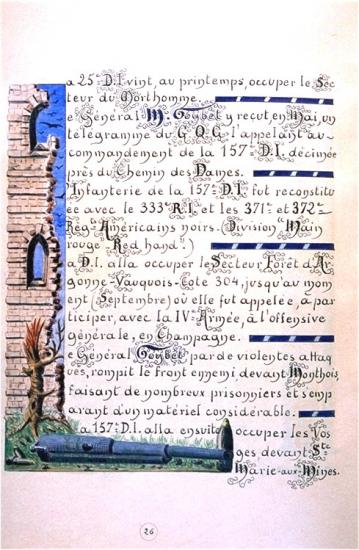 Familly Book of Mariano Goybet about African American troops of his Red Hand Division
Familly Book of Mariano Goybet about African American troops of his Red Hand Division
Distinguished service medal given by General Pershing .
“My dear General, the President delegated me to confer you the Distinguished Service Medal in the name of the United States government”
“As Commander of the 157th French Division of Infantry, you have been an important factor in the success of the allies by your valiant leadership and eminent tactical ability. The officers and soldiers of the 371st and 372nd American Iinfantry Regiments count it a great honor to have served as part of your command in the operations conducted by you in Champaign and in the Vosges. .”
General Pershing
October 8, 1918
General Order No. 234
“I am proud to forward you herewith the thanks and congratulations of General Garnier-Duplessix and I want at the same time, dear friends of all ranks Americans and French, to tell you as your leader and as soldier, from the bottom of my heart how grateful, I am to you all for the glory you have acquired for our splendid 157th Division.
In these nine hard days of battle you have pushed ahead for eight kilometers , fought powerful enemy organization , captured close to 600 prisoners , taken 15 guns light and heavy , 20 infantry Mortars and artillery ammunition and brought down by rifle 3 aeroplanes . The red hand of this division is now in truth a blood- reeking hand . I grappled the Boche at the throat and made him yell for mercy. Our glorious comrades who died are well avenged.”
General Goybet, Commanding the 157th Division
December 12, 1918
General Order No. 245
“The red hand division during nine days of violent fight was always an exceptional model for the victorious advance of the fourth army.
Dear Friends of America you will be back home to the other side of the ocean, don’ t forget ‘’ The Red Hand Division. ‘’ .”
“Our friendship has been cemented in the blood of the brave and such a link will be never destroyed Remember your General who is proud to have commanded you and be sure of his endless recognition. .”
General Goybet commanding the 157th Division
H.Q. 19 December 1918
General Order No. 248
Officers, Non-commissioned Officers, sappers, soldiers, gunners and cavalry men of the 157th Division :
“The Marshal of France, commander in chief of the French Army, has ordered the dissolution of our division on the 20th of December 1918. It is therefore the last farewell I address to you this day, which is the last one I have the honor to command you. During seven months you gave everything I demanded of you. You have shown yourself strong in the defensive hardy and aggressive in the ‘Coup de mains’ magnificently brave and gallant in the offensive.”
“You have gloriously ended the 157th Division ‘career in the course of the great battle of Champaign, in breaking strongly fortified position, in progressing in a fierce struggle of nine days for more than eight kilometers, taking from the enemy a thousand prisoners, more than 20 guns,, several hundred machine guns and enormous material.
During our mutual life, the powerful bonds which kept us together have been tightened by the sorrow of our cruel losses, as well as in then joy of victory. You gave me your confidence. In my turn I have given you the most precious thing I have to give: MY MILITARY HONOR. It has been put in good hands. With my soldier’s heart I think you.”
“The Divisions elements will be distributed in other organizations. You will take with your traditions of courage, discipline and affection to your new chiefs. To those who will ask were you come from, you will answer with pride, ‘We are the soldiers of the Division Goybet, the Division with the Red Hand: it was a fine Division! And you will give a proof of it by you conduct, In the memory of our dear dead I piously kiss the sacred folds of your banners. They have been worn out in the battle , they now wave on the winds of victory .”
General Goybet
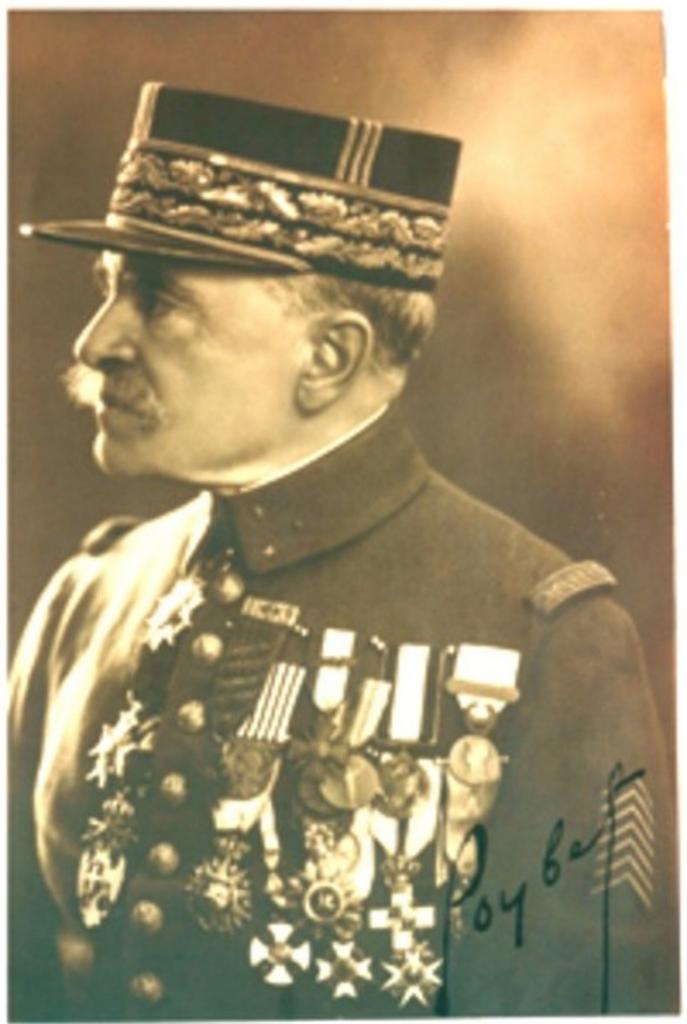
The Leviathan Press give us details on the troops that came back to America.
February 8, 1918
The U.S.S. Leviathan, upon her 11th Westbound trip has on board 11,795 persons, officers and crew total 2241; Navy passengers, 84; Army passengers 9470;
- 371st 104 Officers 2645 Men
- 372nd 76 Officers 2626 Men
There are 2151 sick and wounded aboard in the charge of 15 casual Medical Officers. There was on board the boat 11795 persons. (Other troops on the boat.).
The 371st and 372nd Infantry Regiments (Colored) have seen some of the heaviest fighting of the war , being brigaded with the French .Both regiments have been cited in French Army Orders, and the regimental colors of each decorated just prior to embarkation at Brest . These regiments have received between them - 38 Distinguished Crosses , 168 Croix de Guerres and 2 Legions of Honor.
371st R.I.U.S.
On August 31, 1917 there was organized at Camp Jackson, Colombia, S.C. in accordance with war Department General Order N 109 the First Provisional Infantry Regiment (colored) later designed as the 371st Infantry .
Colonel Perry L. Miles was placed in command of this regiment.
371 R.I.U.S. was decorated with Croix de guerre
For the 371st there was killed and wounded:
-4 officers killed in action, 41wounded in action, died or wounded 5
-Enlisted Men killed 113, wounded 859, died or wounded 25.
CITATION
G.Q.G.
French Armies of the East
Extract
After approval of the General commanding in Chief of the A.E.F. in France, the Marshal of France, Commander in Chief of the French Armies of the East, cites in the order of the Army :
The 371st R.I.U.S.
‘Has shown during its first engagement the very best qualities of bravery and audacity which are characteristic of shock troops
Under the command of Colonel Miles, it launched itself with a superb spirit and admirable disregard of danger at the assault of a position stubbornly defended by the enemy It took it by terrific fighting under an exceptionally violent machine gun fire.”
“It then continued its progression in spite of the fire of enemy artillery and cruel losses taking numerous prisoners, securing cannon, machine guns and important material.”
Petain , Marshal of France
Major Tobe C. Cope 3rd Battalion
Distinguished Service Cross
Major Cope personally led the attacking companies of his battalion during the Champaign offensive . On September 30 he was wounded in the arm by the machine-gun bullets and refused to be evacuated .On October 6, while the remnants of the battalion were in reserve near the town of Ardeuil. Major Cope was hit in the upper lip by a very small piece of shell fragment. The wound was so small that he again refused to have it tended to.. The battalion was pulled out of the offensive and sent into the lines in the VosgesMountains. The Major’s face became infected and he was evacuated while is battalion was in line.
“By the direction of the President under provision of the act of Congress approved July 9, 1918, the distinguished Service Cross was posthumously awarded by the Commanding General American Expeditionary Forces – ‘ For extraordinary heroism in action at Trieres Farm , France , September 30, 1918, wounded in the arm , Major Cope remained on duty throughout the engagement , led his battalion , and encouraged his men by his gallant example and refused to be evacuated .”
The men never flinched
Capt A.V.R. Richard of Laurens, South Carolina who commanded a company of the 371st Regiment, in writing of the men of that regiment said : ‘’ On the afternoon of September 26, 1918, we received orders to move forwards . We slept that night in a French communicating trench. I say slept, but really there was no sleep, as it was raining, and the noise from the guns would not lead one sleep . The French had gone over the top and were pursuing the Huns.
‘’ On Sunday morning my company went over the hill. We arrived at the position the attack was to start from at 7: 30, after having a deadly artillery barrage on us over the hill. At 10 o’clock Sunday morning we were ordered to advance up the valley, but in the meantime an enemy plane flew down low, discovered our position, and signaled his artillery, which opened on us and every minute seemed to be the last one. However, by the rifle fire we brought the plane down, killing the pilot and observer.
‘ Long before we reached the village we could see the cowards running up a steep hill beyond, leaving lots of machine guns to stick out, and believe me, when we reached our objective and rounded up the machine gummers the men the 371st made quick work of them .
‘ In all, during the two days Sunday and Monday, our battalion advanced about five miles without the aid of a single friendly artillery shot or any other help . We killed lots of Germans captured lots of them, and also captured any quantity of material and several big guns.
‘ I am proud of all my officers and all of my men. The whole regiment fought like veterans and with a fierceness equal to any regiment. This was the first time any of them had been under aimed shell and machine-gun fire and they stood it like moss-covered old-timers. They never flinched or showed the least sign of fear. All that was necessary was to tell them to go and they went. Lots were killed and wounded, but they will go down in history as brave soldiers.’
372nd R.I.U.S
372 R.I.U.S. was decorated with Croix de Guerre
In this Regiment there is the famous First Separate Battalion of the District of Colombia
- The 9th Ohio separate battalion: Company L of Massachusetts, the first separate company of Connecticut, The first separate company of Maryland . All these being National Guard troops, and 250 Drafted men from Camp CusterMichigan.
Colonel Tupes commanding the Regiment
The 372nd played a key role in the Meuse-Argone offensive and suffered casualties of 500 hundred men killed or wounded or gassed in action. They fought gallantly at Verdun, Bussy farm and Seichaut to name a few of their other accomplishments .
Two men of the Regiment earned a triple award. Croix de Guerre with Palm, the medaille militaire and the Distinguished Service Cross.
157th D.I. N0 5508
From Colonel Quillet commanding 157th D.I. to Colonel Tupes commanding 372nd Infantry.
The Colonel Commanding the I.D. has recommended your regiment for citation in the order of the French Army worded as follows :
“Gave proof, during the first engagement of the finest qualities of bravery and daring which are virtues of assaulting troops.”
“ Under the orders of Colonel Tupes dashed with superb gallantry and admirable scorn of danger to the assault of a position continuously defended by the enemy, taking it by storm under an exceptionally violent machine gun fire . Continued the progression in spite of enemy artillery fire and very severe losses. They made numerous prisoners, captured cannons, machine guns and important material.”
(Signed) Quillet
Washington men Win Honors
In the 372nd Infantry was the first battalion of the District of Columbia National Guard whose heroes were prevented by the Armistice from winning added glory. It would have fallen to its lot to have the honor of being the vanguard of the French Army of Occupation .Of the nearly 600 District of Columbia colored men who were with the 372nd at least 200 were wounded more or less seriously, and about 33 were killed.
The District of Columbia men proclaimed sergeant Ira Payne as the hero of heroes among the District of Columbia fighters. He wears the Croix de Guerre and ‘Isn’t afraid of devil himself’, according to the men of his company.
Sergeant Payne speaks modestly of this exploits.He says: “ during the fighting at Sechault the Germans were picking off the men in my platoon from behind the bush and kept up a deadly fire in spite of our rifle fire directed at the bush. We did our best to stop those machine guns, but the German aim became so accurate that they were picking off five of my men every minute. We couldn’t stand for that, so I decided I would get that little machine gun nest t myself and I went after it . I left our company, detoured, and by a piece of luck got behind the bush. I got my rifle into action and knocked off two of those German machine gunners. That ended it. The other German couldn’t stand so much excitement. The Boches surrendered , and I took them in our trenches as prisoners .”
Another man is Benjamin Butler, a private, awarded the Croix de Guerre. His citation reads:‘ For displaying gallantry and bravery and distinguished himself in carrying out orders during the attack on Sechault on September 29, 1918, under heavy bombardment and machine gun fire ‘
January 23, 1919
Order General N 1599
The General commanding the forth Army cite to the order of the army:
“General of Brigade Goybet Mariano Francisco Julio commanding the 157th Division:
Remarkable General Officer, full of strength,, vivacity and a communicative confidence.
He took the command of his Division at the moment of its reorganization with Black American troops. Grace to his very personal action, to his untiring activity and his perfect tact, succeed to transform in a few month this great unit in a splendid combat instrument.”
“During the hard battle of Champaign , from the 27 of September to the 6 of October, he realized with his Division a glorious advance shooting the enemy from successive positions strongly defended , taking many prisoners , guns and considerable materiel.”
The general commanding the IVArmy
Gouraud
November 17, 1918
10th Army Corps
Staff (French)
General Order No. 339
‘’It has been an honor for the 10th Army corps to receive and welcome the 157th Division after is success in Champagne .”
“During the few weeks that the division belonged to the Army Corps its Regiments of Americans and French have by their conduct and biting activity produced the best impression”.
“It had prepared in its sector the ways of penetrating in Alsace and it should have deserved the honor of entering it . But military necessities bring today the higher command to consider its use in another part of the front and to give to the Americans a part of the front facing Belgium, Luxemburg and a corner of Lorraine.”
“The General commanding the 10Th Army Cops sees with pain the gallant Division and her Chief General Goybet move away from him.. He cannot defend himself from the painful thought that General Goybet will not have the consolation of treading with his Division that reconquered land that keeps the remains of one of his sons.”
“To all he wishes good luck and express the hope of meeting again one day”
( signed) VANDENBERGER
General, commanding the 10th Army Corps

General Goybet had his three sons engaged in the first conflict. Two of them died and one was under his orders. Sergeant Frederic Goybet died in the Vosges in 1914 and Adjudant Adrien Goybet killed in front of Some Py in 1915.
Marguerite Lespiaud , the wife of General Goybet writes in her private journal about him.
“During the war he had no fear to cross two times a day fields sprinkled by heavy artillery shells to be close to his wounded.”
“He walked under fire beside his men. Two times wounded to the leg,, he didn’t leave the front the first time and few times the second time . He shortened always his leaves to go back to the danger. If he had a sick soldier we guessed it immediately.”
“One day my daughter, upon seeing him excessively preoccupied with a light –infantry alpine man , said to him :
- “Father they are not your children!”
- “Yes they are!” he said and that was true.
BY THEIR SACRIFICE, CITIZENS OF THE USA , CITIZENS OF THE WORLD
Distinguished Service Cross
Private Holmes Burton ( Deceased ). “ For extraordinary heroism in an attack in the Champaign sector Hill 188, Sept 28, 1918. Private Holmes after his automatic trifle was out of commission and he himself badly wounded, returned to the company’s headquarters of his own volition, got a reserve automatic rifle, went back and fired with it on the enemy until he was killed.. This happened under heavy machine gun and shell fire.”
Croix de Guerre, Silver star
Private Lee Robert (deceased). For extraordinary heroism in an attack on Hill 188, Champagne sector. September 28, 1918. Private Lee showed remarkable bravery and disregard of personal danger under heavy machine gun and shell fire. Being caught in a shell hole by the crossed fire of two enemy machine guns, he helped to kill the crew of a machine gun nest and was still fighting when killed .
Speaking about black men and women engaged in the war effort Emmet J. Scott writes:
“It is difficult to indicate which rendered the greater service to their country. – The 400,000 or more of them who entered active military service (Many of whom fearlessly and victorious fought upon the battlefields of France) or the millions of others loyal members of this race whose useful industry in fields, factories, forest, mines, together with many other indispensable civilian activities, so vitally helped the federal authorities in carrying the war to a successful Conclusion.
General Pershing on those Troops:
“A tour of inspection among American Negro troops by officers of these headquarters shows the comparatively high degree of training and efficiency among these troops. Their training is identical with that of other American troops serving with the French Army, the effort being to lead all American troops gradually to heavy combat duty by a preliminary service in trenches in quiet sectors.”
“Colored troops in trenches have been particularly fortunate as one regiment had been there a month before any losses were suffered. This was almost unheard of the western front.”
‘The exploits of two colored infantrymen in repelling a much larger German patrol, killing and wounding several Germans and winning the Croix de Guerre by their Gallantry, has aroused a fine spirit of emulation throughout the colored troops, all of whom looking forwards to more activity service.”
“The only regret expressed by colored troops is that they are not given more dangerous work to do. I cannot commend to highly the spirit shown among the colored combat troops, who exhibit fine capacity for quick training and eagerness for the most dangerous work .”
Former President Roosevelt on the Negro’s part in the war :
Carnegie, Hall New York, on November 2, 1918
Extract
“Well, thank Heaven we went in, and our men on the other side, our sons and brothers on the other side, white men and black, white soldiers and colored soldiers, have been so active that every American now can walk with his hand up and look the citizen of any other country in the world straight in the eyes, and we have the satisfaction of knowing that we have played the decisive part.”
“And now friends I want as an American to thank you, and as a your fellow American to congratulate you upon the honor won and the service rendered by the colored troops on the other side.”
What the Negro go out the war by E.J. Scott
Extract
“What has American Negro go out of the war? Time alone can bring the full answer to this sweeping question. To some of the manifold implications which the query itself involves, however, some answers can already be made. For one thing the war has brought to the American Negro a keener and more sharply defined consciousness, not only of his duties as a citizen, but of his rights and privileges as a citizen of the United States. The colored people of America performed to the utmost of their ability the duties which the war imposed upon all citizens, black and white alike.”
“A summery of what the Negro wants may be stated: He wants justice in the courts substituted for lynching, the privilege of serving on juries, the right to vote, and the right to hold office like others citizens. He wants, moreover, universal suffrage, better educational facilities, the abolition of the ‘Jim Crow’ car, discontinuance of unjust discriminatory regulations and segregation in the various departments of the Government, the same military training for Negro Youths as for white, the removal of ‘dead lines’ in the recognition of fitness for promotion in the army and navy, the destruction of the peonage system, an economic wage scale to be applied to white and blacks alike, better housing conditions for Negro employees in industrial centers, better sanitary conditions in the Negro sections of cities and reforms in the Southern penal institutions . If after having fulfilled the obligations of citizenship Negroes do not get these things, then indeed, they feel, will the war have been fought in vain.”
From E. J. Scott, Special adjutant to the secretary of war. The American Negro in the
World War ; 1919 Chapter XXXI
In the Southwestern Christian Advocate of New Orleans, Louisiana , the Reverend Dr Robert E. Jones, an outstanding leader of the Negro race, voices the sense of this new recognition of the Negro’s position as a citizen. He says:
Extract
“The Negro has won his decorations in France on soldierly merit. He has won at the same time by manifestation of his courage and his devotion and his loyalty , a more even chance in American life . And the victory should be made sure. And let us not mince words . We do not intend now that we have served the Nation in every war of the republic and that we have borne our full share, according to our capacity, in every phase of the world war, to further accept the indignities heaped upon us as a race without a solemn protest to every sense of conscience and right in America and without appeal to the sense of conscience of civilization the world over.”
“There is one thing this World War has done. It has lifted the Negro problem out of the provincialism of America into the circumspection of the civilized world.
We purpose to carry our cause into the circumspection of the civilized world.”
“We purpose to carry our cause into the open forum of the world. We purpose to let the world know that the soldiers that brought glory to the American flag on the fields of France are denied the common courtesies in too many cases when they return home.
And surely our appeal to the world will not fall altogether on deaf ears. There will be an awakening, you may rest assured, a sense of right and of justice that will react upon American life. We make this appeal to the world in no sense of disloyalty to our nation. We do it because we are loyal . We will be heard. We will not be lynched and robbed and hedged about without a solemn protest. We do not plead for pity or sympathy. We want what we have earned by every rule of the game.”
Reverend Dr. Robert E. Jones
“The valiant conduct of black troops in the World War, their loyalty, their self-sacrifice in front of danger, their blood poured with bravery in fields of shell and under the machine-gun bullets helped I think colored people to be more conscious of their rights because they were very proud to save the world from the barbarian and they felt not only citizens of USA but citizens of the world with all the rights that goes with that new world citizenship .”
Henri Goybet , Grandson of General Goybet who commanded black troops to freedom the nations in the World War. December 11, 2007
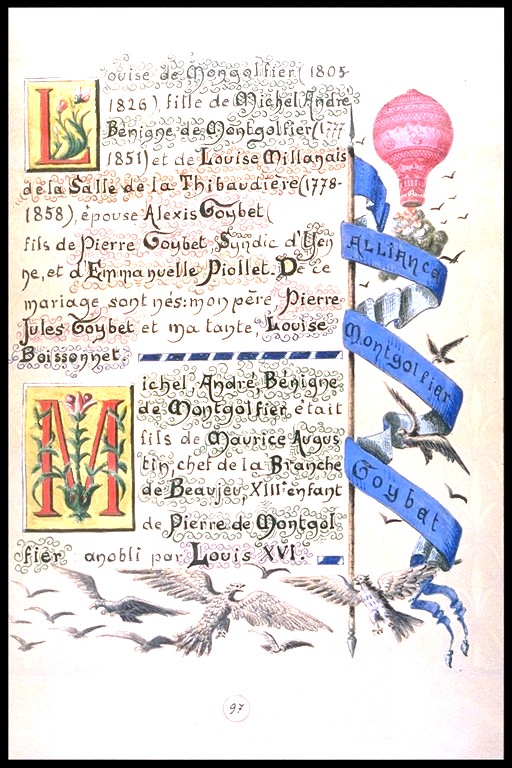
A page from thé Familly Book. link between Montgolfier Familly and Goybet Familly
THE FAMILY BOOK AND THE FANION of 157th Red hand Division.
It was written by my great grandfather between 1898 and 1931.
He said in this book- I begin this book as Captain. if God wishes it, I hope to finish it as General of Division.
The cover of the book is in leather with inside 200 pages richly illuminated with letters in gold, silver and many kinds of others elements.
In this book you can see the fanion composed of the 333rd French Infantry (white) , the 371st infantry and 372nd American infantry (colored).
The composition of the division is shown in the make up of the divisional flag. French flag with an American flag as a field and a red hand, the divisional insignia in the white panel.
Captain Chester D. Heywood in his book spoke about Colonel Miles commanding the 371st regiment said that the men in the regiment were very proud of the Red Hand “ I remember” he says that “most of our officers and men hated to take it off.”
The Ministry of War in Paris states that at no time this emblem was recognized or recorded. It was worn, so far as the French were concerned, by mere tolerance and therefore no historical data was ever kept about the Red Hand insignia.
The French helmet symbolizes the service with the French
I have a letter of my great-grand father’s written by General Miles, commanding the 371st regiment dated from 13 November 1933.
“Naturally we have thought to you and spoke of you many times at our annual dinner. We had everyone present sign our program. Here it is.”
“You imagine that it is decorated with the reproduction of your Division Fanion that you have so graciously offered to us.”
“They were very proud of the Red Hand and they also remain proud of their service in the 157th French division and of their distinguished chief ‘’Our General.’’ .”
“This year some of our officers have traveled more than 7OO miles to reach Washington and to attend our meeting.”
“With best wishes and appreciation of your friendship and the manner in which you commanded us.”
“I am your friend and admirer.”
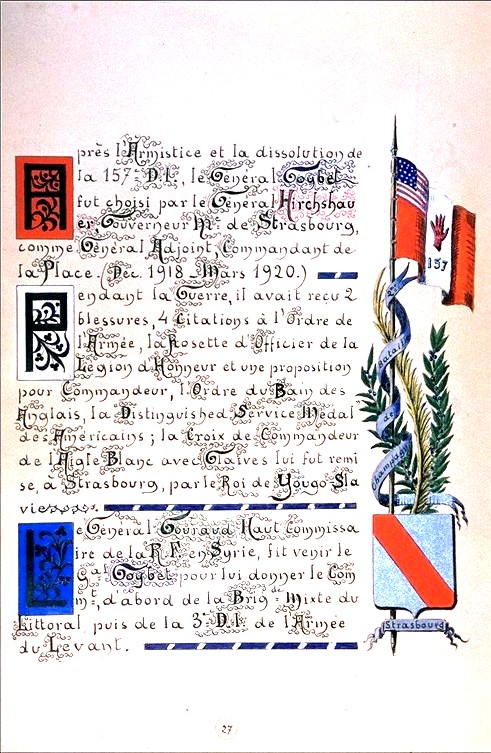 Familly Book of Mariano. We can see thé Red Hand flag
Familly Book of Mariano. We can see thé Red Hand flag
DAMASCUS , THE HOLY CITY
In 1920 General Goybet was called by General Gouraud to command the third division of Levant.
The Arab revolt begun in 1916 goes as far as Damascus. It is a fight for the independence of Arabs from Ottoman Empire (Turks). “Laurence of Arabia” helped the Arabs in this fight on the side of Faysal.
They are helped with the English troops of General Allenby.
The first of October 1918Damascus is taken.
We have, I think changed the current of history in the Near East,, I ask myself how the great powerful nations will let the Arabs have their way.
T.E. Lawrence October 18, 1918
Faysal is proclaimed King of Syria in March 1920. The powerful nations will share the Near East at the conference of San Remo in Italy in April 1920. Mandate has been given to France on Lebanon and Syria.
July 1920, the 24th Division commanded by General Goybet marches on Damascus. After the fight at Khan Meiseloun , the General Goybet with his troops arrives victorious in Damascus. Faysal has escaped.
GENERAL ORDER No. 22
Aley, 24 July 1920
‘’The General is deeply happy to address his congratulations to the General Goybet and his valiant troops: 415th of line , 2nd Algerian sharpshooters , 11th and 10th Senegalese sharpshooters, light-infantry-men of Africa, Moroccan trooper regiment , batteries of African groups , batteries of 155, 314, company of tanks, bombardment groups and squadrons who in the hard fight of 24 of July , have broken the resistance of the enemy who defied us for 8 months. “”
“They have engraved a glorious page to the history of our country.”
General Gouraud
An ancestor of General Goybet had been made prisoner in Damascus. It is Jean Montgolfier during the Second Crusade in 1147.
“ Isn’t it justice that allowed to the descendant of the slave to come in victorious to the HolyCity.”’ Mariano Goybet
Mariano was appreciated by his chiefs that found him a good tactician and a very cultivated man. He was friend with General Gouraud , Debenay, Petain . They admire his personnel library. He had passion for the arts and drew very well. The family book he made is an example of his artistic side. He liked also poetry.
He had a correspondence with his favorite author Rudyard Kipling.
Here an extract from the private journal of Marguerite Lespieau , wife of Mariano
“As an officer at General Headquarters, , Mariano understood all questions and astonished his chiefs . He was Chief of the 159th, 30th Alpine battalion during the war. No one took care more of his men. I remember that in 1912 a controller was so amazed by the way the 30th battalion was maintained, that before leaving Grenoble , he wrote to the Minister of War.”
“This letter permitted this magnificent battalion to represent Alpine troops at the July 14th celebration{ in Paris}. My husband, an excellent skier always accompanied his Alpine troops and accomplished with them surprising alpine prowess in the most difficult places and without accident. Everything was foreseen.”
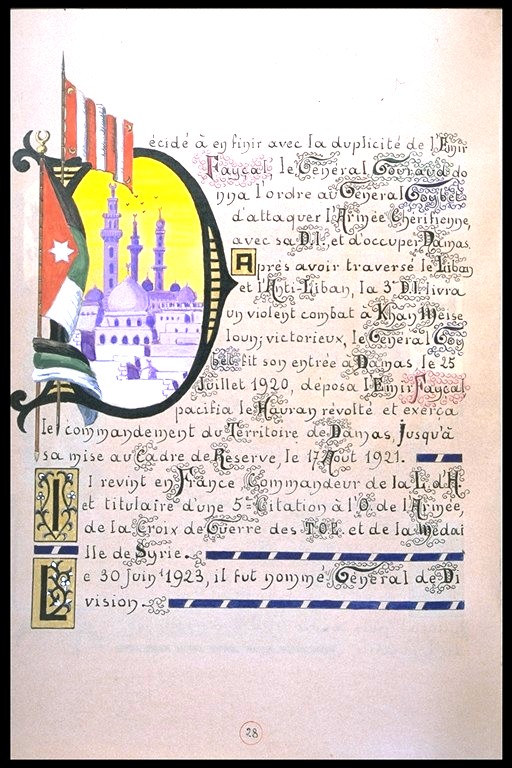 When général Goybet took the city of Damascus. Détail from thé Familly book
When général Goybet took the city of Damascus. Détail from thé Familly book
MILITARY TRADITION IN THE FAMILLY
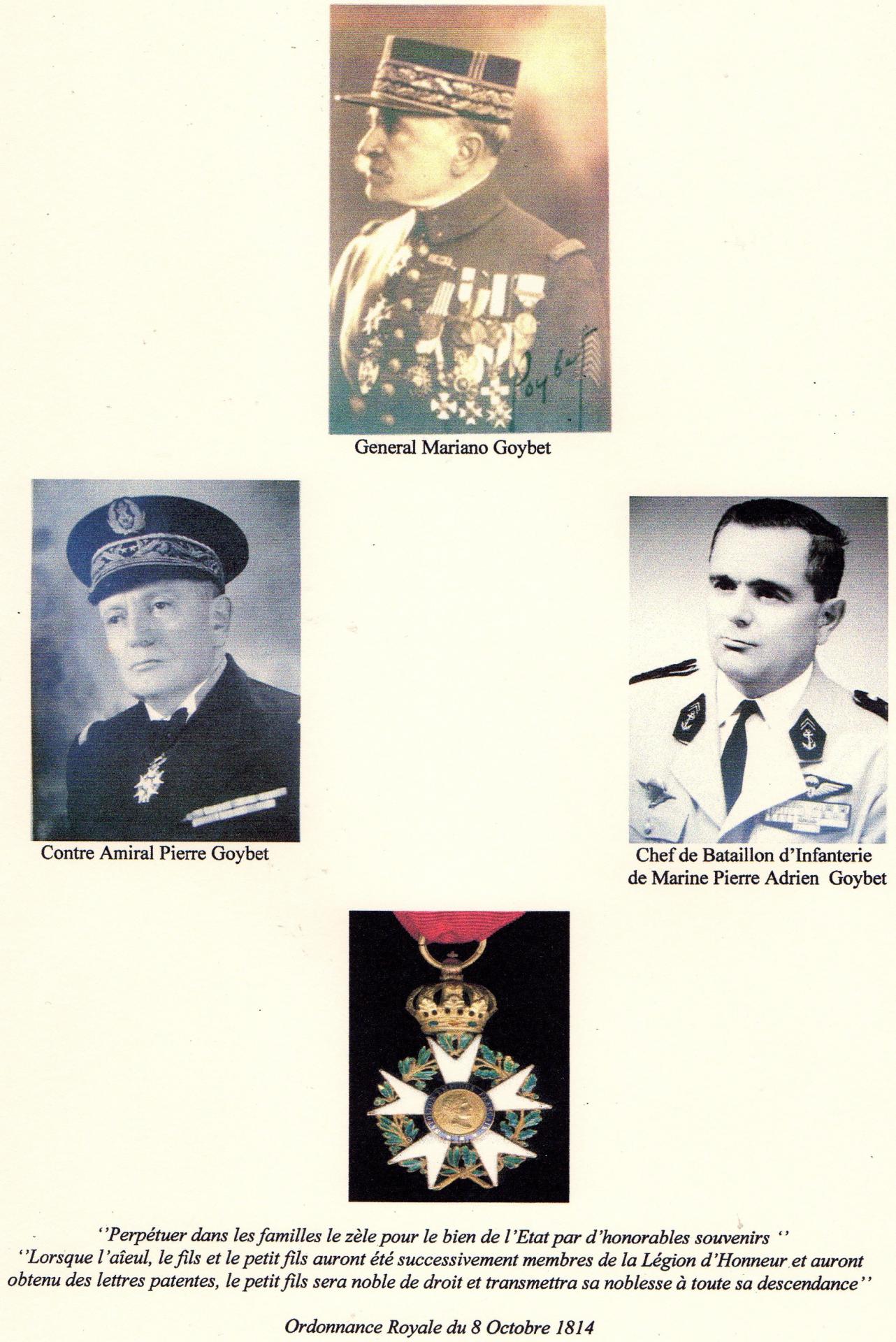 3 générations of légion d'honneur
3 générations of légion d'honneur
CHARLES GOYBET (1825-191O) Division General
His uncle Charles Goybet was in the cavalry in the Army of Sardinia. He made an Italian campaign, Crimea. In 1860 he was squadron chief in the lancers of Florence and he choose France . He finished his brilliant career as General Inspector of French Cavalry
VICTOR GOYBET (1845-1947) Division General
His brother Victor was General in the Alpine troops. He participated to the defense of Verdun. He occupied Mayence in 1917.
HENRI GOYBET (1868-1958) Vessel Captain
His brother Henri was Captain and organized the defense of Paris by creating 10 section of cars with projectors .He is also Chief general staff of the Admiral Ronach in 1917.
PIERRE GOYBET (1887-1963) Rear Admiral
The third son of Mariano is Rear Admiral Pierre Goybet. He was in the fight in Verdun.
He commanded the cruiser Primauguet and landed at Aruba in the Antilles in April 1940 to protect Standard and Shell Petroleum installations against attacks from the Germans.
June 25, 1940 , he brought a part of the French Gold Reserve from the Bank of France to Casablanca (Morocco) to be protected from the Germans.
November 1942, Casablanca
Debarcation of the Americans…He is the commanding officer of the port of Casablanca. He receives Generals Patton , Kees and Wilburg to discuss the cessation of hostility.
ADREN GOYBET (1922-1995) Marine Infantry Battalion Chief
My father Adrien Goybet, the son of the Admiral, was Battalion Chief in the Marine Infantry . He was trained with British troops under the orders of Lord Admiral Mountbattan (Force 136 whose commandos inspired the famous movie “Bridge Over the River Kwai”.
He is parachuted in 1945 into Cambodia that was at that time occupied by the Japanese He prepared the landing of the troops of General Leclerc. He made the Indo-Chinese Campaign (1951-1954) as an Intelligence service officer as well as the Algerian campaign ( 1958-1961) .
He is a Chevalier of the French Legion of Honor. There is in this family three generations of Legion of Honor recipients. The association of hereditary honors A.H.H. regroups all the families who have the necessary credentials. (Regulation of 1814 by Louis XVIII “to perpetuate in families the zeal for the good of the state by honorable souvenirs”). Chevalier Henri Goybet his son wanted to honor his Great -Grandfather who was in the Alpine troops for his military Service in the 27th Alpine Infantry Division. He is a member of A.H.H. The association includes 300 families in France.
*Something particular is that the family descends from Jeanne d’Artois , Louis VIII and Henry III King of England ( 1207-1272) and has common ancestors with a number of American Presidents, among them George Washington and Franklin D. Roosevelt .
Henri III is the great grandfather of Jeanne d’Artois

SOURCES
- Henri Goybet from his websit Famille du Chevalier Henri Goybet
- Familly book written by Mariano Goybet between 1898 and 1931
- Negro Combat Troops in the World War by Chester D. Heywood 1928
- The American Negro in the World War by Emmet J. Scott 1919
- Henri Jaillard Les Goybet de la vallee de Yenne 25.08.64
- Note from Richard Ford
- Informations d’Henri Goybet
- Photograph and Illustrations by D. Lester Dickson
- Others illustrations from the family book by Mariano
Links to Red Hand Division
Mariano Goybet - Wikipedia, the free encyclopedia
Military history of African Americans - Wikipedia, the free encyclopedia
Freddie Stowers - Wikipedia, the free encyclopedia
E.J. Scott. The American Negro in the World War. Chapter XVI.
371st Infantry Regiment (United States) - Wikipedia, the free encyclopedia
African Americans in World War 1
371st Infantry Regiment 93rd Division (Colored)
Full text of "Two Colored women with the American Expeditionary Forces"
State’s black Medal of Honor winner featured on television program was from Sandy Springs area
Full text of "The negro in our history"


